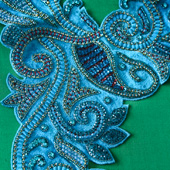Design Resource
Hand Embroidery - Ahmedabad
Traditional Embroidery
by
Prof. Bibhudutta Baral, Divyadarshan C. S., Abhishek G. and Lija M. G.
Initially, designs are drawn on a plastic sheet or tracing sheet. Plastic sheets are mainly used for tracing because it is durable for a long time. Using piercing tools small holes are made on the outlines of the drawn design. The fabric to be embroidered is stretched from the four sides for stiffness and tied to a metal frame. Stencils of costume design are placed on the fabric and the outline of the measurement is marked by stitching the borderlines with needle and thread at the required areas to be embroidered.
A designed plastic sheet is placed on the fabric to trace the design. A thin paste of zinc oxide powder and kerosene is prepared through which the design is traced. The paste is rubbed on the plastic sheet. The zinc oxide paste when rubbed on the designed plastic sheet passes through the pores made and the design is traced on the fabric. Artisan starts to do embroidery work on the traced design with colorful embroidery threads. The thread is held with a finger at the reverse of the fabric and the ari, an awl-like needle with a sharp point shaped like a hook, is held on the top. The ari is pierced through the cloth and the thread is brought to the upper side and locked with the previous stitch. This process is repeated until the desired form is created on the surface of the fabric.
After embroidering a few areas the stitches are hammered. A wooden piece is kept beneath the fabric for support and on the top, the embroidered design is hammered with a wooden mallet to strengthen the stitches. The designs are also embroidered with beads, and golden and silver threads to make the design look more elegant. Sparkling and colorful stones are also glued on the fabric using fabric adhesive, giving the wearer a royal look. After completion of the embroidery work, the fabric is removed from the frame, is reversed to the other side and tied again. Fabric glue is applied to the threads behind the embroidered design so that the threads don’t come out. The fabric is cut and stitched to complete the wear and then packed for sale.
Hand embroidered costumes are made in fewer numbers as it requires more time and labour. The embroidery is mostly done on bridal and traditional wear.





























